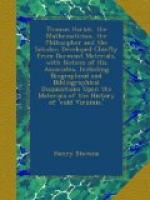However, after a half century’s slumber, when the great fire of London had destroyed his monument, and too late many scholars were minded to attempt the recovery and preservation of memorials of the past, John Collins the mathematician began soundings in the pool of oblivion for Hariot and his papers. He and his correspondents fished up a great deal of truth and history, but so mixed with error and conjecture that the results, though interesting, are misleading.
In the ’ Correspondence of Scientific Men of the Seventeenth Century, Edited by Professor S.J. Rigaud, 2 volumes, Oxford 1841,’ 8°, are found the following instructive and amusing passages :
As for Geysius, he published an Algebra and Stereometria divers years before the first edition of the Clavis [of Oughtred, 1631] was extant in Mr. Harriot’s method, out of which Alsted took what he published of algebra in his Encylopasdia printed in 1630, the year before the Clavis was first extant (see Christmannus and Raymarus). Mr. Harriot’s method is now more used than Oughtred’s, and himself in the esteem of Dr. Wallis not beneath Des Cartes. Dr. Hakewill, in his Apology, tells you Harriot was the first that squared the area of a spherical triangle; and I can tell you, by the perusal of some papers of Torporley’s it appears that Harriot could make the sign of any arch at demand, and the converse, and apply a table of sines to solve all equations, and treated largely of figurate arithmetic. His papers fell into the hands of Sir Thomas Aylesbury, father to the Lord Chancellor’s lady, where I hope they still are, unless they had the hard fate to be lent out, before the fire, and be burned, as some have said.
Collins to Wallis, no date, circa 1670, vol. ii, page 478.
As to Harriot, he was so learned, saith Dr. Pell, that had he published all he knew in algebra, he would have left little of the chief mysteries of that art unhandled. His papers fell into the hands of Sir Thomas Aylesbury, who was father to the late Lord Chancellor’s [Clarendon] Lady,by which means they fell into the Lord Chancellor’s hands, to whom application was made by the members of the Royal Society to obtain them: his lordship




